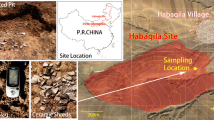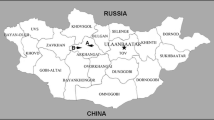Abstract
The emergence of the Xiongnu State in Mongolia reflected a period of increasing foreign influence, especially from China. Metallurgy was likely one of the key cultural components that may have reacted sensitively to this influence. In our ongoing project focusing on metallic objects excavated from the royal Xiongnu tomb at Golmod 2, we found a group of bronze artifacts possessing an important clue as to the general understanding of the contemporary Xiongnu bronze industry. The assemblage in question consists of 21 exotic ornaments, each nearly identical in shape and size and all associated with the horse-drawn wagons interred in the tomb. They were made of copper alloys containing on average 3.8 % arsenic, 3.0 % lead, and 1.3 % tin by weight. This recipe was a continuation of the unique steppe bronze tradition drawing on the copper-arsenic system as dictated by limited access to tin. The addition of lead, however, was a notable departure driven apparently by Xiongnu-Han interaction. This development likely reveals an important facet of the Xiongnu communities seeking a refined adjustment to the bronze recipe. This enhancement likely served to meet the growing demand for exotic items such as those under consideration, whose stylistic characteristics have led to erroneous conclusions as to the political affiliation of their producers.








Similar content being viewed by others
References
Allard F, Erdenebaatar D, Batbold N (2002) A Xiongnu cemetery in Mongolia. Antiquity 76:637–638
Bagley RW (1987) Shang ritual bronzes in the Arthur M. Sackler collections. The Arthur M. Sackler Foundation, Washington, D.C. and The Arthur M. Sackler Museum, Harvard University, Cambridge, Massachusetts, Distributed by Harvard University Press
Barfield T (2001) The shadow empires: imperial state formation along the Chinese-nomad frontier. In: Alcock S, D’Altroy T, Morrison K, Sinopoli C (eds) Empires: perspectives from archaeology and history. Cambridge University Press, Cambridge, pp 10–41
Barnard N (1961) Bronze casting and bronze alloys in ancient China. Monumenta Serica monograph 14. The Australian National University and Monumenta Serica, Canberra
Brosseder U (2009) Xiongnu Terrace Tombs and their Interpretation as Elite Burials. In: Bemmann J, Parzinger H, Pohl E, Tseveendorzh D (eds) Current Archaeological Research in Mongolia (Papers from the First International Conference on Archaeological Research in Mongolia, held in Ulaanbaatar, August 19th–23rd 2007) Bonn Contributions to Asian Archaeology 4, Bonn, pp. 247–280
Chernykh EN, Kuzminykh SV (1989) Ancient metallurgy in northern Eurasia (seyma-turbino phenomenon). Academy of Sciences of the USSR Institute of Archaeology, Moscow Nauka (in Russian)
Craddock PT (1979) The copper alloys of the medieval Islamic world – inheritors of the classical tradition. World Archaeology 11(1):68–79
Erdenebaatar D, Iderkhangai T, Mijiddorj E, Orgilbaiar S, Batbold N, Galbadrakh B, Maratkhaan A (2015) Investigation of Xiongnu elite burials GOL MOD-2 at Balgasyn Tal. Excavation Report, Ulaanbaatar
Eregzen G, Park JS, Erdenebaatar D (2013) Archaeological explanation and chemical analysis of some bronze artifacts of the #1 royal Xiongnu tomb in Golmod 2. Journal of Archaeology, History and Culture 9(8):5–19
Honeychurch W (2014) Alternative complexities: the archaeology of pastoral nomadic states. J Archaeol Res 22:277–326
Khavrin SV (2011) Metal of the Xiongnu period from the Terezin cemetery, Tuva. In: Brosseder U, Miller BK (eds) Xiongnu archaeology Multidisciplinary perspectives of the first steppe empire in Inner Asia. Rheinische-Friedrich-Wilhelms-Universitat, Bonn, pp 537–538
Lechtman H (1999) The production of copper-arsenic alloys (arsenic bronze) by Co-smelting: modern experiment, ancient practice. J Field Archaeology 26:497–526
Miller BK (2012) Vehicles of the steppe empire: chariots and carts in Xiongnu tombs. The Silk Road 10:29–38
Miller BK, Allard F, Erdenebaatar D, Lee C (2006) A Xiongnu tomb complex at Gol Mod 2 cemetery, Mongolia (2002–05). Mongolian Journal of Anthropology, Archaeology and Ethnology 2(271):1–21
Park JS, Eregzen G (2015) A preliminary study on the loss of iron and arsenic in the re-melting of iron-bearing arsenical copper. Archaeometry 57(5):869–878
Park JS, Eregzen G, Yeruul-Erdene C (2010) Technological traditions inferred from iron artefacts of the Xiongnu Empire in Mongolia. J Archaeol Sci 37:2689–2697
Park JS, Honeychurch W, Chunag A (2011) Ancient bronze technology and nomadic communities of the middle Gobi desert, Mongolia. J Archaeol Sci 38:805–817
Polosmak NV, Tseveendorj D, Bogdanov ES (2007) Noin-Ula No. 20 Tomb. In: National Museum of Korea (eds) Xiongnu, the First Empire of the Steppes; Archaeological Research of its Tombs (Papers from an International symposium in celebration of the 10th anniversary of MON-SOL Project, Seoul, December 7th 2007) Seoul, pp. 156-176
Rawson J (1990) Western Zhou ritual bronzes from the Arthur M. Sackler collections, Volume IIA, Ancient Chinese bronzes from the Arthur M. Sackler Collections, The Arthur M. Sackler Foundation, Washington, D.C. and The Arthur M. Sackler Museum, Harvard University, Cambridge, Massachusetts, Distributed by Harvard University Press
Rehren T, Boscher L, Pernicka E (2012) Large scale smelting of speiss and arsenical copper at early Bronze age arisman, Iran. J Archaeol Sci 39:1717–1727
Reimer PJ, Baillie MGL, Bard E, Bayliss A, Beck JW, Blackwell PG, Bronk Ramsey C, Buck CE, Burr GS, Edwards RL, Friedrich M, Grootes PM, Guilderson TP, Hazdas I, Heaton TJ, Hogg AG, Hughen KA, Kaiser KF, Kromer B, McCormack FG, Manning SW, Reimer RW, Richards DA, Southon JR, Talamo S, Turney CSM, van der Plicht J, Weyhenmeyer CE (2009) IntCal09 and Marine09 radiocarbon age calibration curves, 0–50,000 years BP. Radiocarbon 51:1111–1150
So J (1995) Eastern Zhou Ritual Bronzes from the Arthur M. Sackler Collections. Volume III, The Arthur M. Sackler Foundation in association with The Arther M. Sackler Gallery, Smithsonian Institution, Distributed by Harry Abrams, Inc
Stuiver M, Reimer PJ (1993) Extended (super 14) C data base and revised CALIB 3.0 (super 14) C age calibration program. Radiocarbon 35:215–230
Umehara S (1937) Rakuyo Kinson Kobo Shuei (Outstanding specimens from the ancient tombs of Chin-ts’un, Loyang). Kobayashi Shuppan-bu, Kyoto
Acknowledgments
The Department of Archaeology, Ulaanbaatar University of The National University of Mongolia, is acknowledged for offering objects to be examined. Valuable comments by two anonymous reviewers helped to improve the manuscript and are gratefully acknowledged. We thank Mr. Jason Buschman for his linguistic assistance with this manuscript. This work was supported by the National Research Foundation of Korea (NRF) grant funded by the Korea government (NRF-2014K2A8A1067324).
Author information
Authors and Affiliations
Corresponding author
Rights and permissions
About this article
Cite this article
Park, JS., Diimaajav, E. & Gelegdorj, E. Evolution of Mongolian bronze technology with the rise of the Xiongnu State. Archaeol Anthropol Sci 9, 789–798 (2017). https://doi.org/10.1007/s12520-015-0304-x
Received:
Accepted:
Published:
Issue Date:
DOI: https://doi.org/10.1007/s12520-015-0304-x




